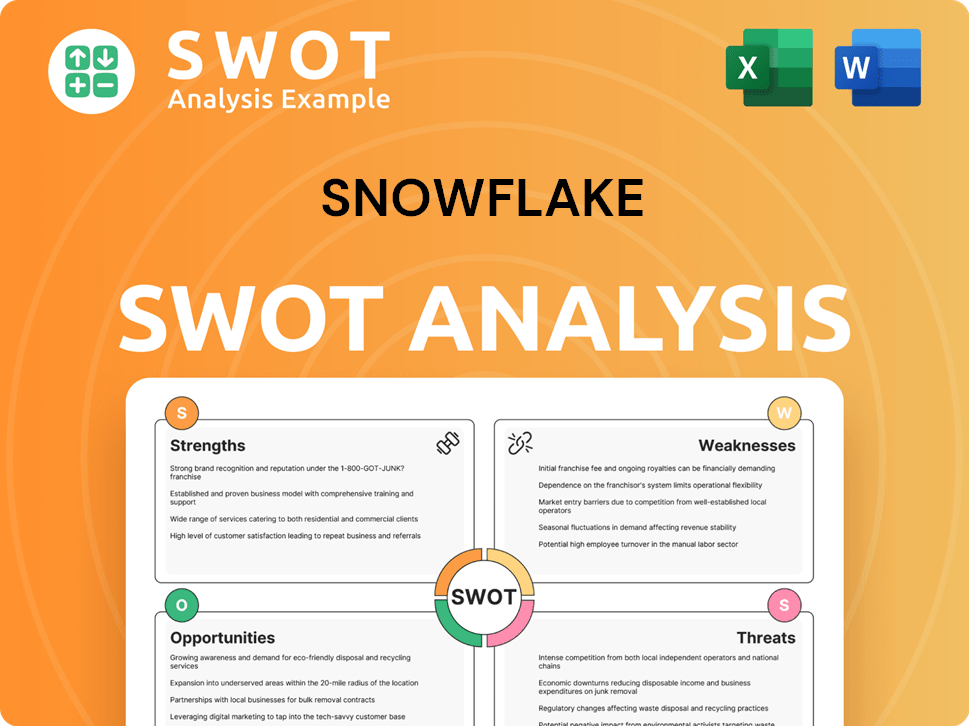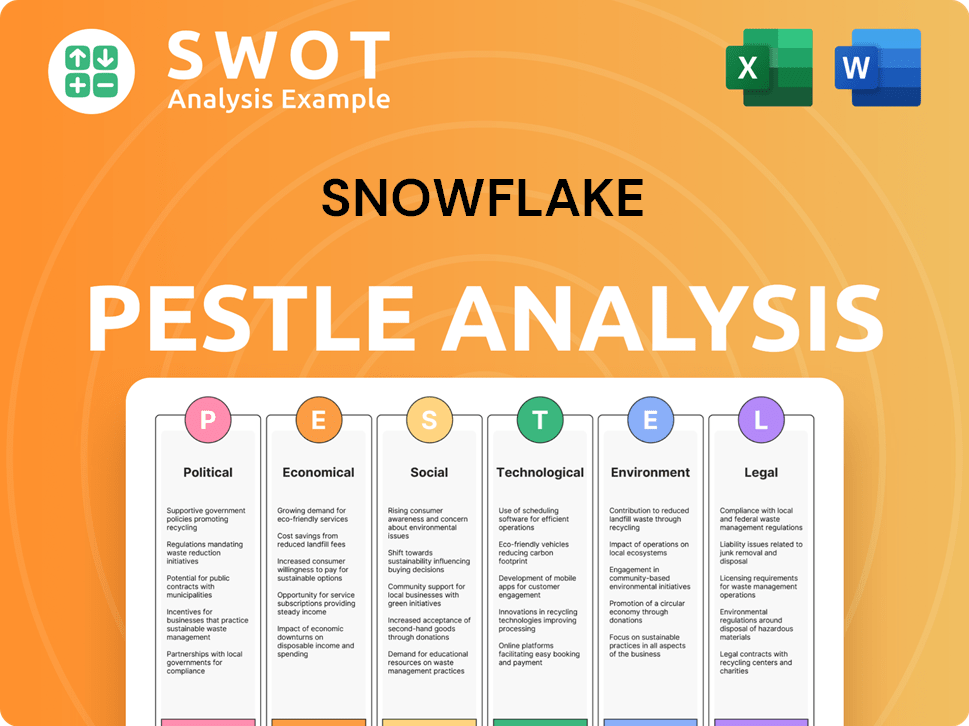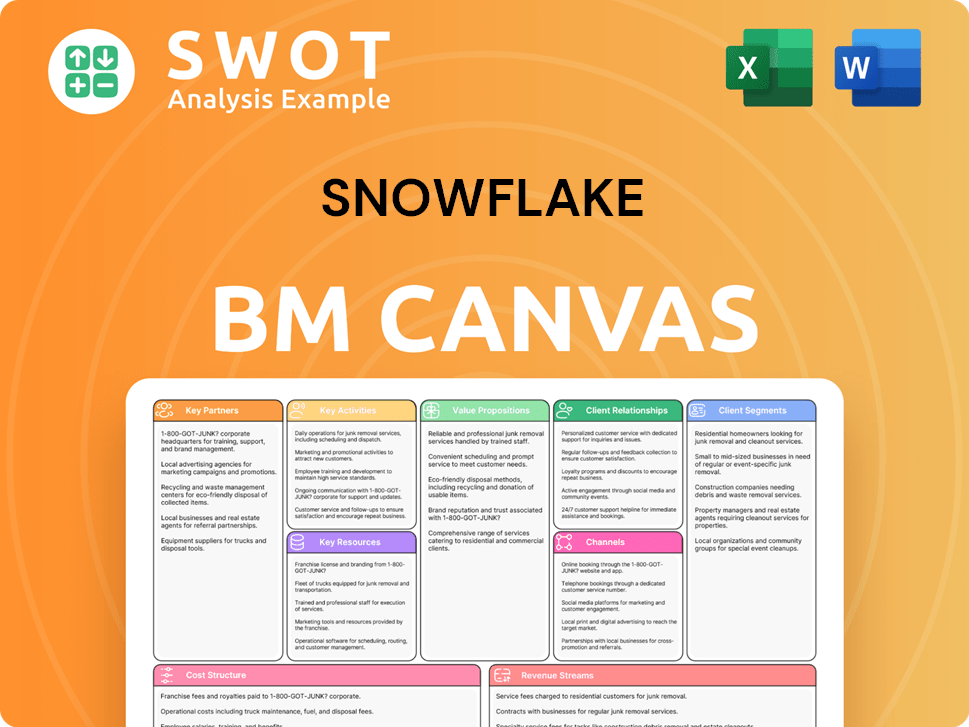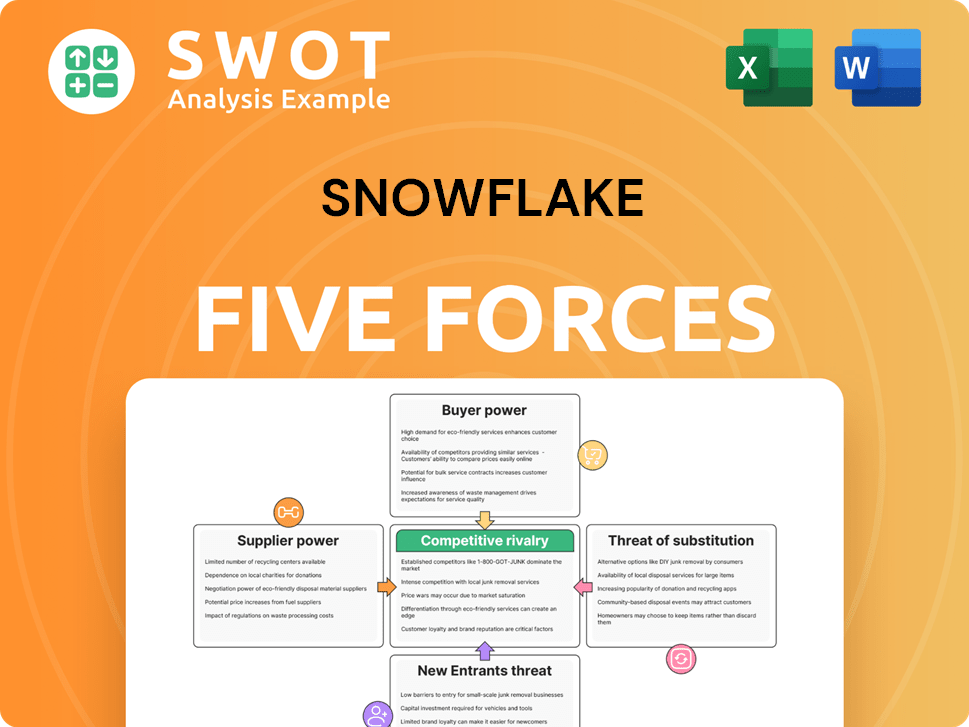Snowflake Bundle
Can Snowflake Maintain Its Dominance in the Data Cloud?
Snowflake has rapidly transformed how businesses handle data, but the cloud data platform market is fiercely competitive. This analysis dives deep into the Snowflake SWOT Analysis, exploring the company's position amidst a sea of rivals. Understanding Snowflake's competitive landscape is crucial for anyone seeking to navigate the complexities of the data warehousing world.

This exploration will dissect the Snowflake competitors, evaluating their strengths and weaknesses in relation to Snowflake's offerings. We'll examine Snowflake market share and its growth trajectory, providing insights into its strategic moves and future prospects. The goal is to equip you with the knowledge to assess Snowflake's position in the cloud data platform market, comparing it with other major players in cloud computing and data warehousing.
Where Does Snowflake’ Stand in the Current Market?
Snowflake holds a significant market position within the cloud data platform industry, often recognized as a leader in data warehousing and data lakes. The company's success is reflected in its strong financial performance and the wide adoption of its Data Cloud platform.
The company's primary offering, the Data Cloud, supports a broad range of workloads, including data warehousing, data lakes, data engineering, data science, and applications. This versatility allows Snowflake to serve a diverse customer base across various industries, from financial services to healthcare.
Snowflake's strategic positioning has evolved from a data warehouse solution to a comprehensive data cloud, emphasizing data sharing, collaboration, and the development of data-intensive applications. This evolution reflects the growing demand for data democratization and real-time analytics.
Snowflake consistently ranks among the top providers in the cloud data platform industry. In fiscal year 2024, product revenue reached $2.86 billion, a 38% increase year-over-year. This financial performance underscores its substantial market presence.
Snowflake serves a broad spectrum of customers, from large enterprises to small and medium-sized businesses. The company's customer base spans various industries, including financial services, healthcare, retail, and media. This diverse customer base contributes to its market stability.
Snowflake has a strong presence in North America and is actively expanding in EMEA and APAC regions. This global expansion strategy is crucial for maintaining its competitive edge in the cloud data platform market. The company’s international growth is a key factor in its overall market position.
The Snowflake competitive landscape includes hyperscale cloud providers and specialized data analytics firms. Continuous innovation is essential for Snowflake to maintain its strong market standing. Understanding the Snowflake competitors and their offerings is crucial for strategic planning.
The company faces ongoing competition from major players in the cloud computing space, requiring continuous innovation to maintain its market position. The Snowflake market share is influenced by its ability to differentiate itself through features, pricing, and customer service. For more insights into the company's financial structure, you can read about the Owners & Shareholders of Snowflake.
Snowflake's key differentiators include its cloud-native architecture, ease of use, and support for various data types and workloads. These features contribute to its strong market position and appeal to a broad customer base.
- Cloud-native architecture for scalability and performance.
- User-friendly interface and ease of deployment.
- Support for data warehousing, data lakes, and data engineering.
- Data sharing and collaboration capabilities.
Snowflake SWOT Analysis
- Complete SWOT Breakdown
- Fully Customizable
- Editable in Excel & Word
- Professional Formatting
- Investor-Ready Format

Who Are the Main Competitors Challenging Snowflake?
The competitive landscape for data warehousing and cloud data platforms is intense, and faces a diverse set of rivals. The main competitors include major cloud providers, traditional data warehousing vendors, and emerging players. These companies compete on features, pricing, and ecosystem integrations, constantly vying for market share.
The market is dynamic, with mergers, acquisitions, and new entrants reshaping the competitive environment. Companies continually innovate, focusing on niche areas and new technologies to gain an edge. Understanding the competitive landscape is crucial for assessing market dynamics and making informed decisions.
The primary competitors of the company are the hyperscale cloud providers, traditional data warehousing vendors, and emerging players in specialized data analytics. These companies compete on features, pricing, and ecosystem integrations. The competitive landscape is constantly evolving due to mergers, acquisitions, and new entrants.
Amazon Web Services (AWS), Google Cloud, and Microsoft Azure are significant competitors. They offer integrated cloud ecosystems and substantial resources. These providers often bundle data services with other offerings, providing a comprehensive suite of services.
Oracle and Teradata are adapting to cloud-based solutions. They aim to retain their enterprise customers by transitioning their on-premise expertise to the cloud. These vendors are leveraging their existing customer relationships and industry knowledge.
Databricks is a notable competitor, particularly for machine learning and AI workloads. It emphasizes open-source compatibility and a unified approach to data and AI. These players often focus on specialized areas and innovative technologies.
The competition involves feature comparisons, pricing strategies, and ecosystem integrations. Companies aim to gain market share by highlighting performance, cost-efficiency, and ease of use. Mergers and acquisitions also reshape the competitive landscape.
New entrants continually emerge, focusing on niche areas or leveraging novel technologies. Serverless computing and advanced AI/ML capabilities are key areas of innovation. These factors intensify the competition within the cloud data platform market.
Companies differentiate themselves through performance, cost-efficiency, and ease of use. The ability to integrate with various tools and platforms is also crucial. Focus on specific customer needs and emerging technologies is also important.
The Snowflake competitive landscape is shaped by various factors, including the strengths and weaknesses of its competitors. For instance, AWS Redshift offers a fully managed data warehouse service, leveraging AWS's extensive infrastructure. Google BigQuery is known for its serverless architecture and real-time analytics. Azure Synapse Analytics combines data warehousing and big data analytics. These Snowflake competitors have significant resources and existing customer bases. Understanding the Snowflake market share and the strategies of these rivals is essential for assessing its position in the cloud data warehouse market. For a detailed comparison, consider reading a comprehensive analysis of the company's performance and competitive positioning, such as the one available here: Snowflake's competitive analysis.
The company's competitive advantages include its cloud-native architecture, ease of use, and scalability. However, it faces challenges from established players with integrated ecosystems. Understanding these strengths and weaknesses is key to evaluating the company's market position.
- Advantages: Cloud-native architecture, ease of use, scalability, and pay-as-you-go pricing.
- Disadvantages: Competition from hyperscalers, pricing complexity, and vendor lock-in concerns.
- Market Dynamics: The cloud data platform market is experiencing rapid growth, with increasing demand for data warehousing and analytics solutions.
- Customer Base: The company serves a diverse customer base, including enterprises across various industries.
Snowflake PESTLE Analysis
- Covers All 6 PESTLE Categories
- No Research Needed – Save Hours of Work
- Built by Experts, Trusted by Consultants
- Instant Download, Ready to Use
- 100% Editable, Fully Customizable

What Gives Snowflake a Competitive Edge Over Its Rivals?
Understanding the Snowflake competitive landscape requires a deep dive into its core strengths. The company has carved out a significant position in the cloud data platform market through its unique architecture and customer-centric approach. Examining its competitive advantages reveals why it has become a key player in the data warehousing space, attracting a diverse customer base.
Key to Snowflake's success is its ability to innovate and adapt within the rapidly evolving cloud computing environment. This has allowed it to maintain a strong competitive edge and achieve substantial revenue growth. A look at its key differentiators showcases how it stands out from its Snowflake competitors.
Analyzing Snowflake market share and its strategic moves provides insights into its ongoing efforts to maintain and expand its leadership. This involves not only technological advancements but also a focus on building a robust ecosystem that supports its customers' data needs.
Snowflake's architecture separates compute and storage, allowing independent scaling. This design optimizes costs and performance, a key factor in the Snowflake competitive landscape. This architecture supports concurrent workloads without contention, providing flexibility and elasticity.
The Snowflake Data Cloud enables secure data sharing and collaboration. It fosters new business models and insights through its network effect. The Snowflake Marketplace offers access to a wide array of third-party data sets and services, reducing data acquisition friction.
Snowflake has cultivated a reputation for ease of use, performance, and reliability. This leads to high customer retention rates, a critical factor in the Snowflake market share. It focuses on continuous innovation and strong integrations with various tools and platforms to ensure interoperability.
The company's competitive strategy involves continuous innovation to maintain its advantages. While competitors attempt to replicate features, the integrated nature of Snowflake's offering presents sustainable barriers. Snowflake's focus on its customer base and its ability to adapt to market changes are key to its success.
Snowflake's competitive advantages are multifaceted, stemming from its unique architecture, robust ecosystem, and customer-centric approach. These advantages have allowed it to capture a significant portion of the cloud data warehouse market. The company's ability to innovate and adapt is crucial in maintaining its edge against Snowflake competitors.
- Separation of Compute and Storage: This allows for independent scaling, optimizing costs.
- Data Sharing and Collaboration: The Snowflake Data Cloud facilitates secure data sharing.
- Marketplace: Provides access to a vast array of third-party data sets and services.
- Ease of Use and Reliability: High customer retention rates are supported by a strong brand reputation.
- Open Standards and Integrations: Ensures interoperability with various tools and platforms.
Snowflake Business Model Canvas
- Complete 9-Block Business Model Canvas
- Effortlessly Communicate Your Business Strategy
- Investor-Ready BMC Format
- 100% Editable and Customizable
- Clear and Structured Layout

What Industry Trends Are Reshaping Snowflake’s Competitive Landscape?
The competitive landscape for cloud data platforms is dynamic, with several key trends influencing the market. The increasing demand for data storage, processing, and analytics, fueled by digital transformation and the rise of AI/ML, is a significant driver. Simultaneously, data mesh architectures and data democratization initiatives are reshaping data access. Stringent data privacy regulations further impact the competitive environment, requiring robust security and compliance features.
This environment presents both challenges and opportunities for companies like Snowflake. Understanding the competitive dynamics, including the strengths and weaknesses of key players, is crucial for strategic planning and sustained growth. For a detailed look at how Snowflake operates, explore the Revenue Streams & Business Model of Snowflake.
The cloud data platform market is seeing accelerated digital transformation, leading to increased demand for data storage and analytics. The integration of AI and ML is also driving the need for accessible data. Data mesh and data democratization are influencing the market, with a focus on decentralized data access. Regulatory changes around data privacy are also becoming more prominent.
Intense competition from hyperscale cloud providers and the 'data gravity' effect pose challenges. Balancing innovation and profitability in a fast-evolving tech landscape is crucial. Declining demand in specific sectors or aggressive pricing strategies from rivals could also impact Snowflake. Managing costs and ensuring scalability are ongoing concerns.
Expansion into emerging markets presents substantial growth potential for Snowflake. Product innovations, such as enhanced support for unstructured data and real-time analytics, could solidify market leadership. Strategic partnerships with ISVs and data providers can expand its ecosystem. The growing demand for data collaboration and monetization offers fertile ground for Snowflake's Data Cloud.
Snowflake is strategically enhancing its platform capabilities and expanding its partner network. The focus is on industry-specific solutions to solidify its position. The company aims to be the central nervous system for data-driven enterprises. Key strategies include innovation, strategic partnerships, and customer-centric solutions.
The cloud data platform market is expected to continue its strong growth trajectory. The increasing adoption of cloud computing and the need for advanced analytics drive this growth. Key players like Snowflake, AWS, and Google Cloud are investing heavily in innovation and market expansion, with the cloud data warehouse market expected to reach significant values by 2025.
- Snowflake's revenue grew by 36% year-over-year in fiscal year 2024.
- The company is focusing on expanding its customer base, particularly in the enterprise segment.
- Strategic partnerships and product enhancements are key to maintaining its competitive edge.
- The company's market capitalization is a reflection of its strong position in the cloud data platform industry.
Snowflake Porter's Five Forces Analysis
- Covers All 5 Competitive Forces in Detail
- Structured for Consultants, Students, and Founders
- 100% Editable in Microsoft Word & Excel
- Instant Digital Download – Use Immediately
- Compatible with Mac & PC – Fully Unlocked

Related Blogs
- What are Mission Vision & Core Values of Snowflake Company?
- What is Growth Strategy and Future Prospects of Snowflake Company?
- How Does Snowflake Company Work?
- What is Sales and Marketing Strategy of Snowflake Company?
- What is Brief History of Snowflake Company?
- Who Owns Snowflake Company?
- What is Customer Demographics and Target Market of Snowflake Company?
Disclaimer
All information, articles, and product details provided on this website are for general informational and educational purposes only. We do not claim any ownership over, nor do we intend to infringe upon, any trademarks, copyrights, logos, brand names, or other intellectual property mentioned or depicted on this site. Such intellectual property remains the property of its respective owners, and any references here are made solely for identification or informational purposes, without implying any affiliation, endorsement, or partnership.
We make no representations or warranties, express or implied, regarding the accuracy, completeness, or suitability of any content or products presented. Nothing on this website should be construed as legal, tax, investment, financial, medical, or other professional advice. In addition, no part of this site—including articles or product references—constitutes a solicitation, recommendation, endorsement, advertisement, or offer to buy or sell any securities, franchises, or other financial instruments, particularly in jurisdictions where such activity would be unlawful.
All content is of a general nature and may not address the specific circumstances of any individual or entity. It is not a substitute for professional advice or services. Any actions you take based on the information provided here are strictly at your own risk. You accept full responsibility for any decisions or outcomes arising from your use of this website and agree to release us from any liability in connection with your use of, or reliance upon, the content or products found herein.